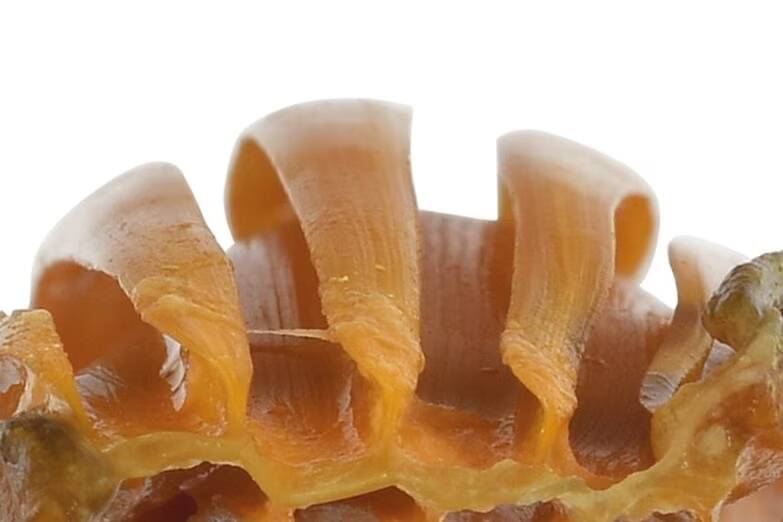For over a decade, an unidentified collection of bizarre shark eggs left Australian scientists baffled — but now, they've discovered that the eggs belong to a new species of demon catshark.

White et al./Journal of Fish BiologyThe new species of demon catshark is notable for its distinctive glowing white eyes.
An unidentified shark egg discovered off Australia’s Kimberley coast in 2011 recently helped researchers identify a new species of demon catshark. The newly discovered shark has distinctive white eyes that scientists say are rare for deep-sea sharks — and could offer a better understanding of how sharks evolve.
According to a report from the Australian Broadcasting Company (ABC), finding the identity of the demon catshark (Apristurus ovicorrugatu) was particularly long and frustrating for scientists from Australia’s Commonwealth Scientific and Industrial Research Organization (CSIRO).
“It’s interesting, because we often get an idea that something might be a new species, but it can take a long time for us to resolve and compare with other species,” said CSIRO’s Australian National Fish Collection senior curator Will White.
Part of the difficulty, White said, was that researchers didn’t have an actual animal to work with. Rather, they had a small collection of unidentified shark eggs found in 1989 and a similar egg found in 2011 by researcher Brett Human, a then-volunteer at the Western Australia Museum.
The eggs were noticeably different from most shark eggs, with strong T-shaped ridges only found in one other shark species, though it was unique among egg-laying sharks in Australia.
Human found the unique egg and connected it to the 1989 collection, but he was only able to identify them as belonging to the genus Apristurus. He was not able to determine their species.

White et al./Journal of Fish BiologyThe T-shaped ridges lining the demon catshark eggs.
“The egg cases possessed very distinctive longitudinal ridges on their surfaces which were T-shaped in cross-section,” White told Live Science. “Only one other species in the world has been found to have egg cases with that form of ridging and that is a different genus entirely.”
White described the journey to identify the new species as “frustrating.” But he and colleagues had a major breakthrough while combing the Australian National Fish Collection’s archives — a similar Apristurus specimen found in the same region as the eggs had been misidentified as a South China catshark (Aprsiturus sinensis).
It was a female and happened to be carrying an egg case that matched the ones found in 2011.
“Luckily the female specimen we found contained an identically ridged egg case and confirmed our suspicions,” White said.
And in another stroke of luck, the female was pregnant, and researchers found a late-term embryo inside one of the egg cases.

White et al./Journal of Fish BiologyThe late-term embryo found inside one of the egg cases observed by White and colleagues.
With the egg case mystery solved and Apristurus ovicorrugatus identified, researchers were finally able to piece together a more comprehensive understanding of this demon catshark.
Demon, or ghost, catsharks are one of the most diverse shark genera worldwide, with around 40 known species, but A. ovicorrugatus is especially unique due to its glowing white eyes.
“Normally, [demon catsharks’ eyes are] always very dark — either dark green or just black eyes,” White said. White irises have only been found in one other deepwater shark species, Apristurus nakayai from New Caledonia and Papua New Guinea.
“It must have evolved for some particular reason, not just within one species, but within a group of species,” he said.

White et al./Journal of Fish BiologyA close-up of the white irises unique to the newly discovered demon catshark species.
“It has definitely opened up research questions about a different evolutionary pathway that we hadn’t considered within this group,” White added.
This new species of demon catshark was found in water at a depth of more than 2,300 feet where it had laid its eggs on top of coral. As White explained, these sharks are not often observed due to the depth at which they occur.
“If you look at that coastline, where it’s usually quite steep and drops off quickly, they have a relatively narrow depth distribution,” he said. “They’re probably following a habitat in which they lay their eggs on a particular coral species.”
A similar yet distinct species of catshark had previously been found on the other side of the country, just off the Gold Coast. White said the new discovery helped his team link the two species.
“We just know very little about deepwater fauna in Australia,” he said, expressing hope that more discoveries will be made in the coming years.
“As more deepwater surveys continue, I think we’ll uncover more species records — there’s still a lot to come.”
After learning about this newly discovered shark species, see the scariest sea creatures in the world. Then, learn about thalassophobia, the crippling fear of open water.





